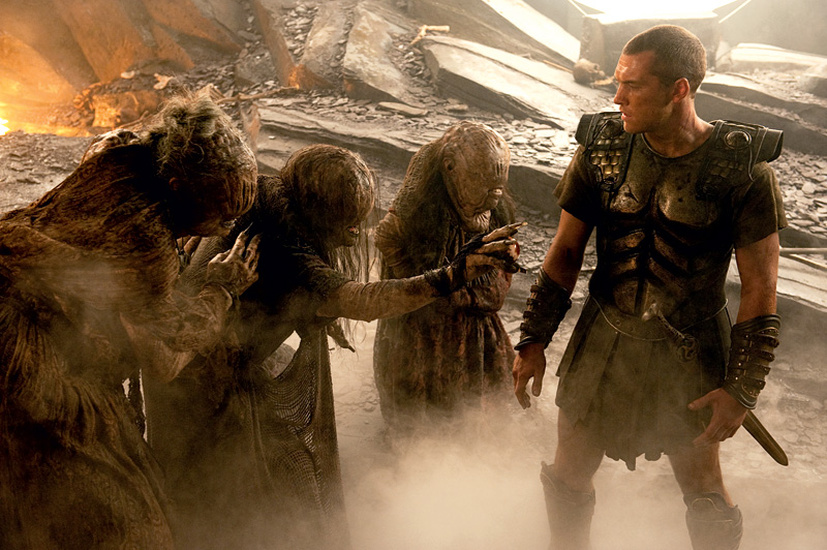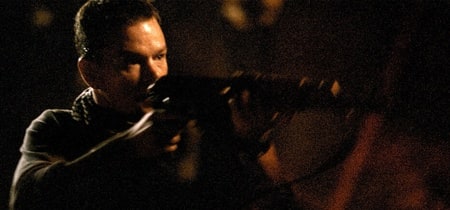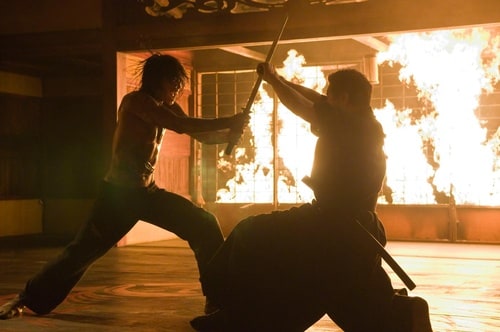Clash of the Titans is the latest demonstration of Hollywood's erroneous belief that any appalling work of screenwriting can be made palatable if enough money, CGI and British accents are thrown at it. An update of the 1981 cult classic of the same name, the movie is a rowdy heroes & villains video-game-style extravaganza direly lacking in personality and character. On the one hand it's a marvellous visual experience featuring a handful of magnificent widescreen images, but on the other it's shallow, underwhelming, underdone, frustratingly cold at its core, and marred by a grim self-serious tone unsuitable for the material. In other words, there's lots of sound and fury, but it comes at the expense of...well, everything else.

In essence, Clash of the Titans is a re-telling of the legend of Perseus, with Zeus (Neeson) growing irritated that the humans are no longer showing the Gods proper respect. Zeus' brother Hades (Fiennes) wishes for the inhabitants of Argos to pay for their insolence, and offers the mortals a short period of time to sacrifice Princess Andromeda (Davalos). If Andromeda remains alive after 10 days, a colossal beast known as the Kraken will be released from the depths of the sea to destroy the city of Argos. Into this conflict enters Perseus (Worthington), the demigod son of Zeus who only recently learned of his lineage and holds a grudge against Hades for the death of his adopted family. Backed by a squad of Argos soldiers (including Mads Mikkelsen, Nicholas Hoult, and Liam Cunningham) and a cursed priestess (Arterton), Perseus sallies forth to uncover a way to defeat the Kraken.
A lot of fuss has been made as to whether or not this film deserves to be viewed in 3-D. See, Clash of the Titans was originally created in 2-D, but, in the shadow of Avatar and its $2.6 billion box office earning, the studio ordered a hasty 3-D conversion a mere month before the film's release to milk it for as much money as possible (Cash of the Titans, anyone?). For those interested in seeing this movie, see it in 2-D - Clash of the Titans is not worth the extra few bucks. The 3-D effects are bad. For the most part, it's just 2D in different planes, which looks utterly unconvincing and functions as a strong, pertinent argument against this type of "quickie" conversion. If Avatar was one step forward for proving the merit of 3-D movies, Clash of the Titans is a trembling step backwards.

Filmmaking techniques have changed tenfold since 1981. The original Clash of the Titans featured the specialised stop-motion animation of Ray Harryhausen which characterised the picture, but this 2010 remake is a determined blockbuster overloaded with state-of-the-art digital effects and bursting with large-scale action beats. While director Louis Leterrier clung to shameful shaky-cam techniques to "enhance" the battles, the action sequences are at least comprehensible. At the very least, Clash of the Titans is a fun actioner. However, the CGI effects are very in-your-face obvious; a fault only augmented by the terrible 3-D conversion. In particular, the sequence with Medusa looks phoney and cartoonish. Even Pixar has achieved images closer to photorealism. Meanwhile, the PG-13 rating represents another critical problem. From the outset, it was clear the filmmakers were transforming the 1981 cult classic into an epic, stylised 300-style action film resembling a graphic novel. While 300 (an R-rated film) offered reams of violence and gore, Clash of the Titans is far too sanitised to be satisfying. This isn't to say that relentless, R-rated violence automatically makes the movie good... It just makes a movie much more fun, and sometimes that's just enough to warrant a solid recommendation as opposed to a hesitant one.
Had this Clash of the Titans possessed a sense of humour, audiences might've been given their first 3-D camp classic. All the male characters here have skirts, iconic beards, and sometimes dreadlocks. The gods of Olympus glow while standing on glowing spheres speaking in a variety of accents (Hades is English, Zeus is Irish, etc). Add a bunch of giant, mythical beasts to the mix, and this could have - and should have - been a total hoot. But instead, everything is played with a straight face. How boring.

A lack of characters denotes yet another major flaw. Sure, there are plenty of empty ciphers who deliver dialogue, but none of them attain even a semblance of three-dimensionality or deserve to be called characters. Would a protagonist with a personality be too much to ask? Worst of all, a viewer never really cares if Perseus wins, mainly because we sense the script will keep victory on his side anyway, and there's little tension to suggest otherwise. The film pushes to the fore Australian actor Sam Worthington (last seen in last year's Terminator Salvation and Avatar), who looks the part but whose clenched delivery, inconsistent accent and lack of charisma results in a drab hero. While Worthington is indeed a superior action star, he wasn't right for this part. Meanwhile, Ralph Fiennes and Liam Neeson are terrific in their respective roles, but as for the rest of the actors? Who cares - they barely warrant a mention, let alone screen-time.
Honestly, all of these little problems could be forgiven if only the proceedings were building up to a knock-'em-dead final showdown, but alas the climax is underwhelming. In fact, for an epic movie, Clash of the Titans is desperately underwhelming. The "hero's journey" feels like a quick scuttle from plot point to plot point, and the ending feels rushed - it's as if the budget ran out or the imagination of the screenwriters ran dry.

In spite of its failings (and boy are there many), there's at least a little fun to be had during Clash of the Titans. It certainly knows that it's a big, dumb actioner, and there's an entertainment value that arises from this self-awareness when the action is done right. Problem is, the film too often gets it all wrong, and it's to date the best example of the abominable consequences of misusing the 3-D process.
4.9/10
 Login
Login
 Home
Home 183 Lists
183 Lists 1665 Reviews
1665 Reviews Collections
Collections
 0 comments,
0 comments, 




































